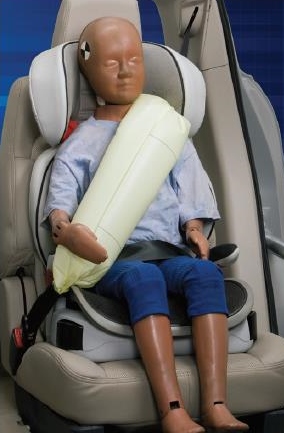ISBs have been an available option in the outboard seating position of some Ford and Lincoln vehicles for the past five years. Over that time, the number of Ford/Lincoln models with this option has grown (see current list, at bottom of page) and now includes both two- and three-row vehicles.
In addition, since Ford’s test program this summer has provided new data to CR manufacturers to help them assess the effectiveness and safety of these belts for CR installation, a number of CR manufacturers have modified their policies for ISB in recent months.
Today, CPSTs are more likely than in the past to come across ISBs in situations where there is no alternative to their use. Would you know how to use one, if necessary?
Editor’s Note:
Although inflatable seat belts can sometimes cause incompatibility problems for CR installation, when CPSTs communicate with caregivers, it is advisable to balance expressions of frustration with an acknowledgement of the safety benefits of these belts for many rear-seat passengers. Caregivers (who have already paid extra for this feature) will be grateful to learn how to safely use CRs in their vehicle while also being respected for their decision to purchase ISBs for the sake of safety.
Practice Scenario
Given the following scenario (seen at a recent checkup event in Seattle), let’s review the steps to take when CRs are used in vehicles with ISBs:
- Child: 20 months old, 32 pounds
- Vehicle: 2013 Ford Explorer; second-row captain’s chairs have ISBs
- Car Seat: Convertible, used rear facing
STEP #1: Determine whether there are alternatives to using an ISB:
- Even when CR manufacturers allow use of ISBs with a particular CR model, most prefer that caregivers use an alternative installation method, such as LATCH or a non-ISB in another seating position, whenever possible.
- In the practice scenario, the boy’s size was appropriate for riding rear facing (which was his parents’ preference), but he exceeded the CR’s RF weight limit for LATCH use, so installation could be done only by using a seat belt. Because the vehicle was equipped with captain’s chairs, the second row had only two seating positions, both with ISBs. And, although there was a third row, it was folded down to accommodate a large dog crate and the stroller, so installing the CR there was not an option. Therefore, installation in this situation was possible only on one of the two captain’s chairs using the ISB.
STEP #2: Learn whether the manufacturers allow CR installation using an ISB:
- As always, consult both the CR and vehicle instructions. Ford allows ISB use with CRs, but defers to the CR manufacturer. Luckily, the owner’s manual for the CR in the practice scenario addressed the topic of ISBs, stating that, if necessary, one could be used for installation. (Note: SRN has chosen not to specify the CR model because instructions could be subject to change in the aftermath of the recent Ford test project.) So both the CR and vehicle manufacturer agreed that the ISB may be used for installation.
STEP #3: Properly use the ISB for CR installation, following both the CR and vehicle manufacturers’ instructions:
- CR manufacturers that allow use of ISBs often do so only given modified installation guidance, so always check CR instructions carefully. Because they are so specific, details for ISB use, when allowed, are often not stated in the CR owner’s manual and must be sought elsewhere (such as the CR manufacturer’s website and/or customer service).
- In this case, although the CR owner’s manual allowed installation with the ISB, it specified that the CR’s lock-off shouldn’t be used with this type of belt, so the CPST followed these revised installation instructions.
- Also, it is important to consult the vehicle owner’s manual, since ISBs are used differently than most seat belts for CR installation and are likely to be unfamiliar to many CPSTs. An ISB system has a sewn-on (nonsliding) latchplate and two retractors, one each for the lap and shoulder portions of the belt. In an ISB system, it is the lap belt’s retractor, located at the anchor point for that belt, that is switchable to ALR mode to enable CR installation.
- After the lap-shoulder belt is run through the CR’s belt path and buckled, pull the lap belt webbing all the way out of its retractor to engage the locked mode, and tighten the installation by pushing slack downward into the retractor spool while pushing down on the CR. The shoulder belt (the part with the inflatable component) will lock only in a crash, but the lap belt stays locked to properly hold a CR.
Vehicles With Ford’s Inflatable Belts
![]() Currently, vehicles with Ford’s inflatable belts as an available option include:
Currently, vehicles with Ford’s inflatable belts as an available option include:
Ford:
- Edge (MY* 2015 and newer)
- Explorer (MY 2011 and newer)
- Flex (MY 2012 and newer)
- Fusion (MY 2013 and newer)
- F-150 (MY 2015 and newer)
Lincoln:
- Continental (MY 2017)
- MKT (MY 2012 and newer)
- MKX (MY 2015 and newer)
- MKZ (MY 2013 and newer)
Note:
This article applies only to use of ISBs in the specific Ford/Lincoln models listed here. Other types of ISBs are options in certain Mercedes-Benz and Lexus vehicles, as well as some airplane seating.
*Model Year

